Search the Special Collections and Archives Portal
Search Results
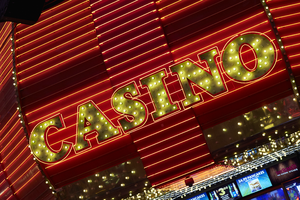
Photographs of Fremont Hotel and Casino sign, Las Vegas (Nev.), March 3, 2017
Date
Archival Collection
Description
The Fremont Hotel and Casino, operating since 1956, sits at 200 Fremont Street inside the Fremont Street Experience. Information about the sign is available in the Southern Nevada Neon Survey Sheet.
Site name: Fremont Hotel and Casino (Las Vegas, Nev.)
Site address: 200 Fremont St
Sign owner: Boyd Gaming
Sign details: Opened 1956, the Fremont was a 15-story high rise, tallest building in Nevada at the time. Boyd Gaming purchased the property in 1983.
Sign condition: 5 - well maintained signage
Sign form: Bullnose Architectural sign
Sign-specific description: Decorated shed that wraps two sides of the property. The neon is primarily red with reader boards spaced throughout. The wrap also has columns of light bulbs. A cabinet with the words "Sam Boyd's" is at the very top of the bullnose at the corner, with the word Fremont directly underneath. A large T.V. screen is in-between "Fremont" and "Casino," which is housed at the bottom of the bullnose.
Sign - type of display: Neon, Incandescent
Sign - media: Steel, Plastic
Sign - non-neon treatments: T.V. screens
Sign animation: Flickering lightbulbs
Sign environment: Property is on Fremont Street, near the Golden Nugget, 4 Queens, and Binion's.
Sign manufacturer: Possibly SSI
Sign - date of installation: c. 1983
Sign - thematic influences: Similar to that of other Fremont Street casino properties, the Fremont has a wrap of neon and incandescent bulbs going around the face of the building. The current signage went up in the 1980s, 20 years after the first of the wraps and bullnoses went up in that area.
Sign - artistic significance: When Sam Boyd purchases the property and changed the signage, it appears he wanted to stay consistent with the other larger casino properties in that area. A decorated shed was put on the building, with a large bullnose on the corner.
Survey - research locations: Vintage Vegas, The Magic Sign, Fremont Hotel Website, Boyd Gaming Website
Survey - research notes: There is a good chance that SSI designed the Sam Boyd signage. There is photo evidence in the Federal Heath photo collection at the Neon Museum showing a piece from the property in their shop back in the early 1980s.
Surveyor: Wyatt Currie-Diamond
Survey - date completed: 2017-09-09
Sign keywords: Architectural; Neon; Incandescent; Steel; Plastic; Bullnose; Video screen
Mixed Content
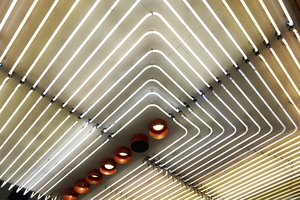
Photographs of Binion's signs, Las Vegas (Nev.), April 18, 2017
Date
Archival Collection
Description
The Binion's Gambling Hall and Hotel, bought in 1951 as the Horseshoe Club, sits at 128 Fremont Street inside the Fremont Street Experience. Information about the sign is available in the Southern Nevada Neon Survey Sheet.
Site name: Binion's Horseshoe (Las Vegas, Nev.)
Site address: 128 Fremont St
Sign owner: TLC Casino Enterprises
Sign details: Opened By Benny Binion 1951, and later say remodels and expansions in 1960 after the purchase of the Boulder Club and 1988 when The Mint was purchase and expanded further and doubled the size. Mr. Binion is known for popularizing the World Series of Poker and brought the game into the mainstream. Binion's Horseshoe was the first casino to put carpeting in a downtown property.
Sign condition: 5 - all of the neon on the property is well maintained and working
Sign form: Concave design, Bullnose elements and decorated shed
Sign-specific description: The property is currently known as Binion's. The horseshoe elements of the property were removed when the Casino changed the name in 2004. The property is a decorated shed, with blue neon signs covering the exterior of the building. The property also has neon signs with the name "Binion's" in a cursive font around the building, along with a large "B" and the world "Gambling" in a western style serif font
Sign - type of display: Neon and Incandescent
Sign - media: Steel
Sign animation: Flickering incandescent bulbs, neon tubes in-between the solid blue flicker.
Sign environment: Downtown Las Vegas, across from Golden Nugget
Sign manufacturer: YESCO and AD-Art
Sign designer: Rudy Crisostomo
Sign architect of record: 1961
Sign - date of installation: 1961
Sign - date of redesign/move: 2005 rebranded as Binion's Gambling Hall
Sign - thematic influences: Similar to other properties on Fremont Street. Property is wrapped with neon and has elements of western flair in the design
Sign - artistic significance: 1960s Downtown started to see the first decorated sheds, and the western style casino was still popular during that time.
Survey - research locations: The Magic Sign, Binion's website, Vintage Vegas
Survey - research notes: https://lasvegassun.com/blogs/kats-report/2010/jan/12/rooms-dark-there-still-action-binions/
Surveyor: Wyatt Currie-Diamond
Survey - date completed: 2017-09-11
Sign keywords: Neon; Incandescent; Steel; Flickering; Bullnose; Architectural
Mixed Content

Group of servicemen (for General Patton) at a party at Walking Box Ranch, Nevada: photographic print
Date
Archival Collection
Description
Bell Family Scrapbook scanning, Set 4, proofed 11.04.2010 Photograph taken when General Patton's troops visited Walking Box Ranch. Photo was taken in the great room of the ranch house. Rex Anthony Bell, Jr (Toni Larbow Beldam) is seated on the floor in the center with a military cap and checkered shirt. George Francis Robert Bell is seated on a wooden 'horse' holding a rope and also wearing a military cap. Clara is seated in the center on an unidentified man's lap with her arm raised. Rex Bell (George Francis Beldam) is located behind Clara's outstretched arm and hand in the back
Image
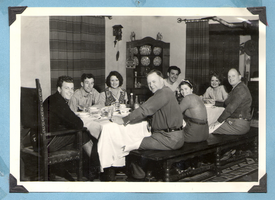
Group of people seated at the dining table in the ranch house at Walking Box, Ranch: Nevada: photographic print
Date
Archival Collection
Description
Bell Family Scrapbook scanning, Set 4, proofed 11.04.2010 Group of people seated at the dining table in the ranch house. From left clockwise around the table; Rex Bell, his brother Hodson Beldam, Marion Lewyn, Lon Chaney, Clara Bow, Louis Lewyn, Hodson Beldam's wife Kathy, Hod Bed Clara and Rex Bell (George Francis Beldam)at either ends of the table. Dinner Party at the ranch. Rex on left, his brother Hodson Beldam and his wife Kathy, then Lon Chaney, Clara, Henry Lewin (producer from Hollywood) and his wife Marian
Image
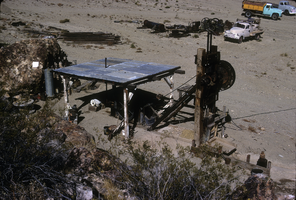
Slide of the old stamp mill, circa 1950s
Date
Archival Collection
Description
Image
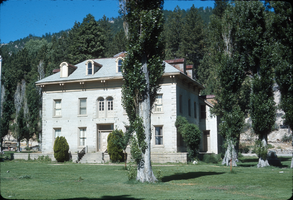
Slide of the Bowers Mansion, Washoe Valley, Nevada, circa 1970s
Date
Archival Collection
Description
Image
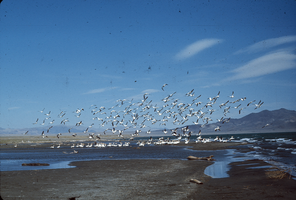
Slide of pelicans at Pyramid Lake, Nevada, circa 1970s
Date
Archival Collection
Description
Image
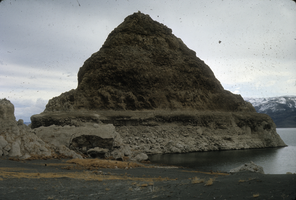
Slide of a tufa deposit in Pyramid Lake, Nevada, circa 1970s
Date
Archival Collection
Description
Image
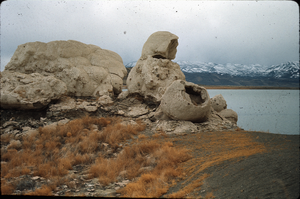
Slide of the rock formation known as The Squaw and Her Basket, Pyramid Lake, Nevada, circa 1970s
Date
Archival Collection
Description
Image
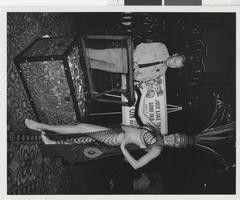
Photograph of a Minsky showgirl posing in front of a poster at the Aladdin Hotel, Las Vegas (Nev.), 1972
Date
Archival Collection
Description
Image
